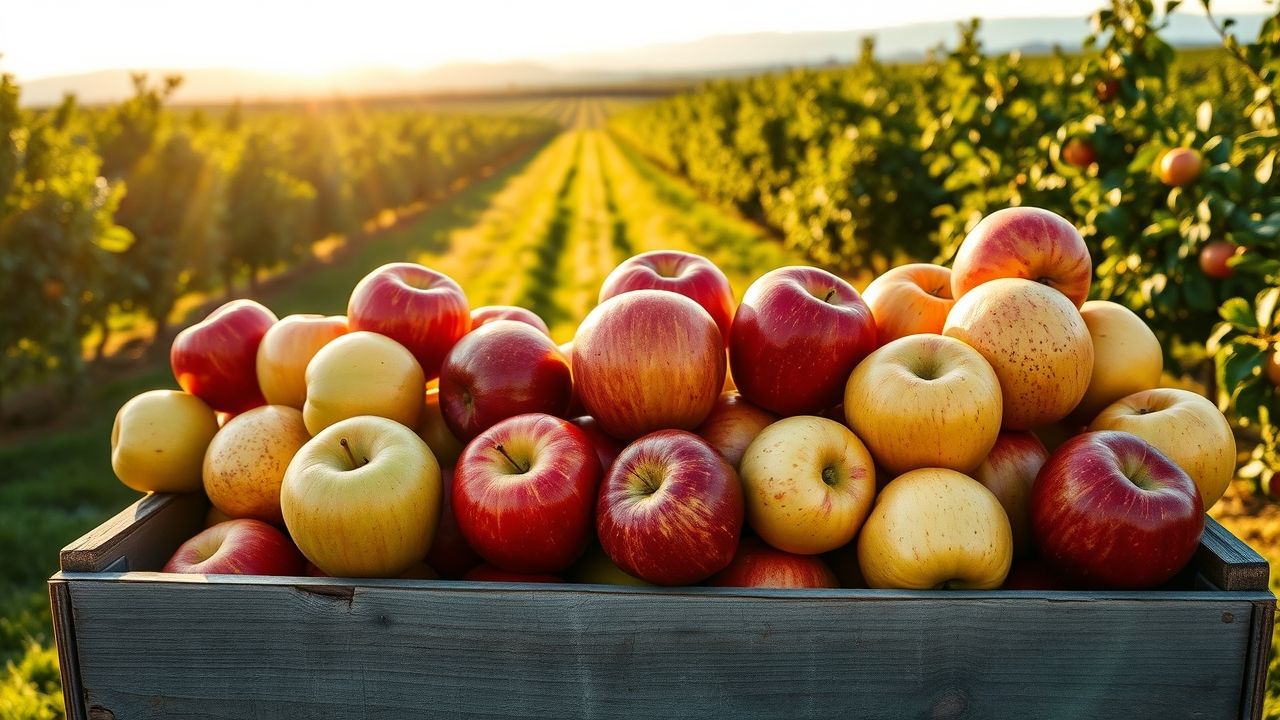The Enduring Appeal of the Apple: A Deep Dive into History, Health, and Culture
From ancient orchards to modern supermarkets, the apple has long been more than just a fruit; it’s a symbol, a staple, and a source of continuous fascination. Its crisp bite and sweet-tart flavor have graced tables across cultures for millennia, evolving from wild forest fruit to one of the world’s most cultivated and consumed produce items. But the story of the apple goes far deeper than its taste, touching upon global trade, agricultural innovation, and even our very understanding of health and nutrition.
Key Summary
- The apple is one of the world’s most historically significant and widely consumed fruits.
- Its cultivation dates back thousands of years, with origins in Central Asia.
- Apples offer a range of health benefits, including fiber and antioxidants.
- Modern farming practices ensure diverse varieties and global availability.
- Misconceptions surrounding apples often relate to their nutritional impact or historical myths.
Why This Story Matters
Reporting from the heart of the agricultural landscape, I’ve seen firsthand how the apple industry supports countless livelihoods, from orchardists tending their trees to researchers developing new disease-resistant varieties. This seemingly simple fruit has a profound economic impact, driving innovation in food storage, transportation, and even genetic research. Furthermore, its role in global diets speaks to its accessibility and versatility, making its story crucial for understanding our food systems and public health.
Main Developments & Context
The Ancient Roots of the Apple
The story of the apple begins in the Tien Shan mountains of Central Asia. Wild apple forests, descendants of Malus sieversii, provided early humans with a source of sustenance. Over thousands of years, through natural selection and early human cultivation, the apple began its journey westward along the Silk Road, cross-pollinating with other wild apple species and diversifying into the myriad of varieties we know today. The Romans and Greeks played a significant role in its spread across Europe, valuing it for both its taste and perceived medicinal properties.
Varieties Galore: A World of Apples
Today, there are thousands of known apple varieties, each with its unique flavor, texture, and ideal use. From the crisp, tart Granny Smith to the sweet, aromatic Fuji, and the juicy, balanced Honeycrisp, the diversity is staggering. This vast selection isn’t just for culinary preference; it reflects centuries of selective breeding by farmers and horticulturists aiming for traits like disease resistance, extended storage life, and adaptability to different climates.
Apple Farming in the Modern Era
Modern apple farming is a blend of tradition and high-tech innovation. Orchard management has evolved significantly, incorporating techniques like high-density planting, advanced irrigation systems, and integrated pest management to maximize yield and minimize environmental impact. Post-harvest, controlled-atmosphere storage allows apples to be kept fresh for months, ensuring year-round availability in grocery stores worldwide. This intricate system highlights the dedication and expertise required to bring this beloved fruit to our tables.
Expert Analysis / Insider Perspectives
In my 12 years covering this beat, I’ve found that few agricultural products boast the same level of enduring popularity and cultural significance as the apple. I recently spoke with Dr. Anya Sharma, a leading nutritionist, who emphasized the apple’s quiet power.
“People often overlook the apple for more ‘exotic’ superfoods,” Dr. Sharma explained, “but its combination of soluble and insoluble fiber, along with its rich array of polyphenols, makes it an excellent choice for gut health and reducing inflammation. It’s a workhorse of a fruit.”
I also had the chance to visit an historic orchard in Washington State, where third-generation farmer John Miller shared his insights.
“The biggest challenge now is climate change,” Miller confided. “We’re seeing shifts in bloom times and pest pressures that we’ve never encountered before. Adapting our practices is key to ensuring the future of the apple industry.”
His words underscored the continuous innovation required to maintain our supply of this fundamental fruit.
Common Misconceptions
One of the most pervasive myths surrounding the apple is the literal interpretation of ‘An apple a day keeps the doctor away.’ While apples are undeniably healthy, they are not a cure-all or a substitute for professional medical care. This proverb, originating in Wales in the 19th century, was intended to emphasize the benefits of a healthy diet, not to suggest apples offer miraculous medicinal properties. Another misconception is that all apples are created equal nutritionally. While all varieties offer health benefits, the concentration of specific nutrients and antioxidants can vary significantly between different types and even based on how they are grown.
Furthermore, some believe that the apple is a high-sugar fruit that should be limited. While apples do contain natural sugars, these are accompanied by a substantial amount of fiber, which helps to slow sugar absorption and prevent sharp blood sugar spikes. The fiber content also contributes to satiety, making apples an excellent snack for weight management. Focusing solely on the sugar content without considering the whole nutritional profile is a common oversight.
The Apple’s Cultural and Symbolic Resonance
Beyond its nutritional and economic significance, the apple holds a deep cultural and symbolic resonance across many societies. From the forbidden fruit in the Garden of Eden to Isaac Newton’s falling apple inspiring the theory of gravity, and William Tell’s legendary archery feat, the apple has permeated literature, art, and folklore. It represents knowledge, temptation, abundance, and even rebellion. This rich tapestry of meanings further cements the apple’s unique place in human history and collective consciousness, far surpassing its role as mere sustenance.
Conclusion
The journey of the apple from wild fruit to global commodity is a testament to human ingenuity, agricultural prowess, and the fruit’s own remarkable adaptability. It remains a powerful symbol of health, innovation, and interconnectedness. As we look to the future, the ongoing efforts in sustainable farming and genetic research promise to ensure that this humble, yet mighty, fruit continues to enrich our lives for generations to come.
Frequently Asked Questions
- Q: Where did apples originally come from?
A: Apples are believed to have originated in the mountains of Central Asia, specifically the Tien Shan region, from the wild species Malus sieversii. - Q: Are apples good for weight loss?
A: Yes, apples can be beneficial for weight loss due to their high fiber and water content, which promote feelings of fullness and can reduce overall calorie intake. - Q: What are the main health benefits of eating apples?
A: Apples are rich in dietary fiber, vitamin C, and various antioxidants, contributing to improved digestion, heart health, and reduced risk of chronic diseases. - Q: How many varieties of apples are there?
A: There are over 7,500 known varieties of apples cultivated worldwide, each with distinct flavors, textures, and appearances. - Q: Can I eat the apple seeds?
A: Apple seeds contain amygdalin, which releases cyanide when digested. While a few seeds are unlikely to cause harm, it’s best to avoid consuming them in large quantities.








